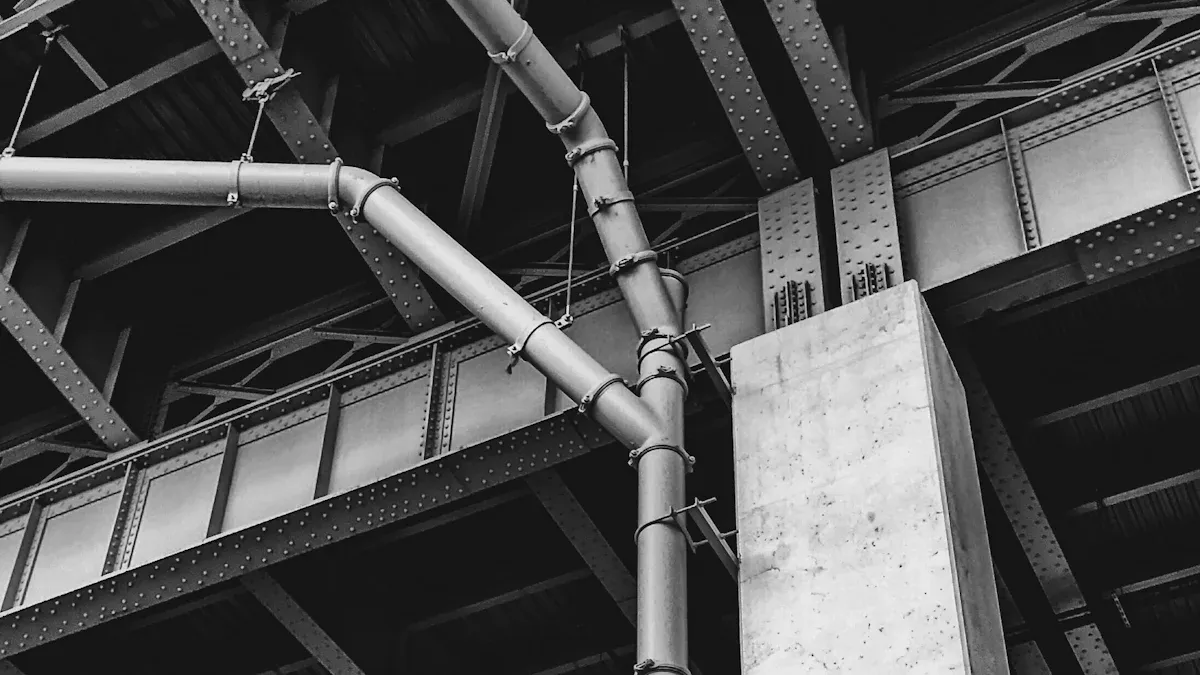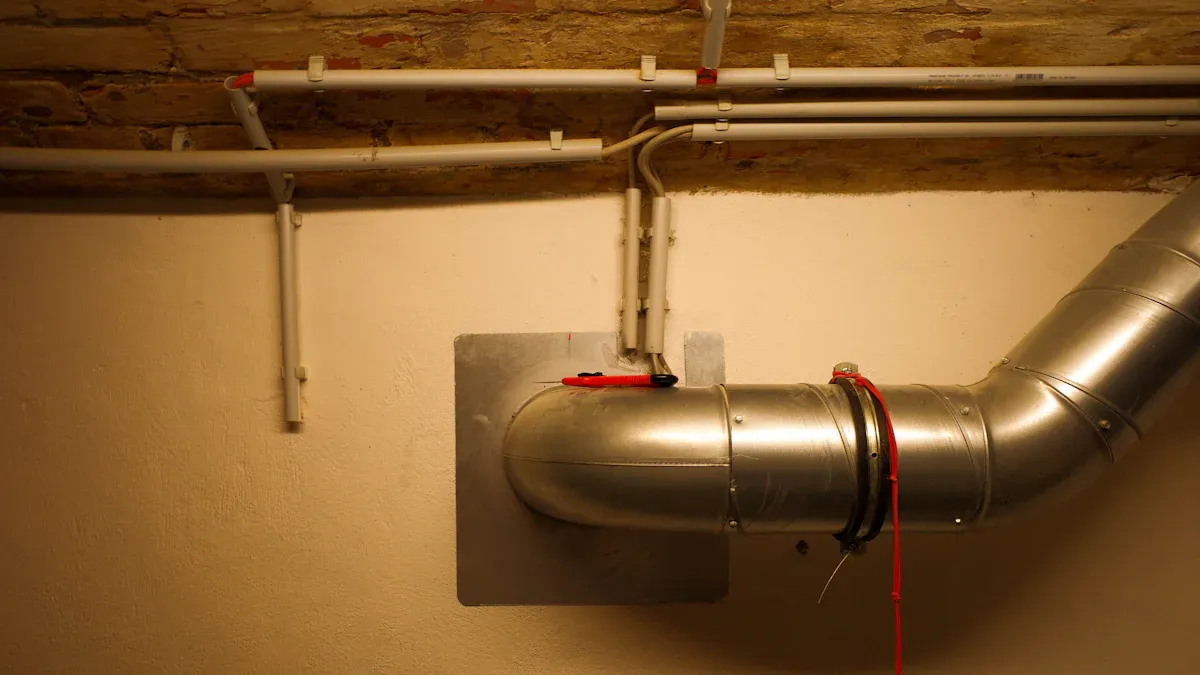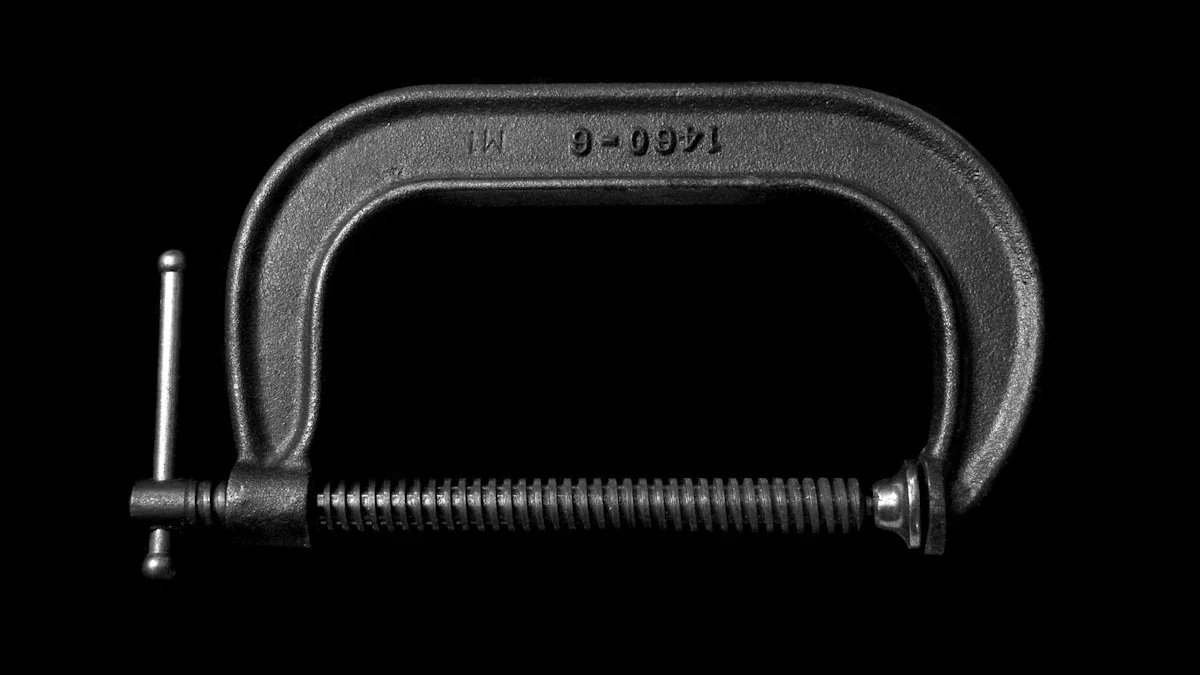Views: 0 Author: Site Editor Publish Time: 2025-10-20 Origin: Site









The best way to support pipes is to pick the right support for each pipe. You should match support products like clamps, hangers, straps, or brackets to the pipe type you use. Some pipes are PVC, copper, steel, or PEX. Using rubber-insulated supports and spacing them well helps stop noise, wear, and leaks. In plumbing, you often see these support types:
Fixed point supports
Guide supports
Line stop supports
Hanger rod supports
Spring supports
U-bolt supports
Trunnion or dummy supports
Saddle supports
Doing these steps makes your system strong. It keeps your pipes safe for a long time.
Pick the correct support for each pipe, like clamps or hangers. This helps keep pipes safe and lasting longer. - Follow the rules for how far apart supports should be. The rules depend on what the pipe is made of and its size. This stops pipes from sagging or moving. - Use supports with rubber insulation to make less noise. These also help stop pipes from wearing out. This keeps your plumbing system safe. - Check pipe supports often to see if they are tight or rusty. This helps you find problems early and saves money on repairs. - Do not make mistakes like using loose supports or installing them wrong. This keeps your plumbing system strong.

You want your pipes to stay safe and last a long time. To do this, you need to follow some important rules for pipe support. First, always use the right support for the pipe material. Each pipe, like PVC, copper, steel, or PEX, needs its own kind of support. You also have to think about how heavy the pipe is and what it carries. If a pipe is heavy or full of water, it needs stronger supports. Insulation around the pipe can change what support you pick. Thick or heavy insulation makes the pipe heavier and changes how the support works.
Tip: Always look at the general arrangement drawings for your pipes. These drawings show where pipes go and help you plan where to put supports.
Pipes get longer or shorter when the temperature changes. This is called thermal movement. If you do not let the pipe move, it can bend or break. You also need to think about sudden forces, like water hammer, earthquakes, or strong wind. These things can shake the pipe, so you need supports that can handle quick movement.
Here is a table that lists the main things to think about when picking pipe supports:
| Parameter | Description |
|---|---|
| Process design conditions | Conditions under which the piping system operates |
| Pipe material of construction | The material from which the pipe is made |
| Piping Loads | Includes weight of the pipe and the fluid it carries |
| Insulation material, thickness, density & specification | Characteristics of insulation affecting support selection |
| Piping GADs | General arrangement drawings for pipe layout |
| Thermal forces, moments & displacement | Forces due to temperature changes affecting support needs |
| Occasional loads | Includes loads from hydro-testing, seismic activity, and wind |
Spacing is another important rule. To keep pipes from sagging or moving, you must follow spacing rules for each pipe type and size. Plumbing codes tell you how far apart to put supports. For example, PEX pipes need supports every 2.67 to 4 feet, depending on their size. Copper pipes can have supports up to 10 feet apart if they are big enough. PVC and ABS pipes usually need support every 4 feet. You can see the differences in this chart:

You should always use the right support for your pipes. This means using pipe clamps, hangers, or brackets that fit tightly. Rubber-insulated supports help stop noise and wear from movement. When you follow these rules, your plumbing will be safe and work well.
Many people make mistakes when putting in pipe supports. These mistakes can cause big problems for your plumbing. The most common mistake is using supports that are too loose. If the support does not hold the pipe tight, the pipe can sag or collect water. This can make pressure build up and even cause the pipe to burst. Another mistake is not installing supports the right way. If you strip bolts or do not tighten them enough, the support can come loose, especially in high-pressure pipes.
Corrosion is another problem. If you do not protect metal supports or pipes, they can rust where they touch. This makes the pipe and support weaker. Over time, this can cause leaks, system shutdowns, or even injuries.
Here is a table that shows common mistakes and what can happen:
| Common Errors | Consequences |
|---|---|
| Loose supports | Can cause pooling, pressure buildups, and ruptures. |
| Improper installation | Leads to stripping of bolts, causing supports to come unhinged, especially in high-pressure systems. |
| Lack of corrosion protection | Results in galvanic corrosion, leading to potential failure of pipes or supports. |
| Long-term consequences include system damage, shutdowns, injuries, and increased costs. |
You can avoid these mistakes by following some easy steps:
Use pipe supports that fit your pipe exactly. Composite wear pads stop metal from touching metal.
Always check the spacing of your supports. Adjustable pipe hangers help stop sagging.
Add wear pads, pipe shoes, or slide plates to stop metal rubbing and rust.
Use linings or coatings to make a barrier between the pipe and the support.
Pick composite supports to keep different metals apart and free from rust.
Put thermoplastic coatings at contact points for extra protection.
Note: The best way to keep your pipes safe is to use the right supports, follow spacing rules, and protect against movement and rust. This keeps your plumbing strong and working for many years.
You need pipe support to keep your plumbing safe from leaks and damage. When you use the right support, you help your pipe stay in place and avoid stress. If you skip proper pipe support, water can seep out and weaken your building’s foundation. Over time, moisture can cause cracks in walls, floors, and ceilings. This can lead to serious problems, like the decay of steel frames or concrete slabs.
A good pipe support system, such as the I-Rod® system, stops water from collecting in hidden spots. It also keeps metal parts from touching each other, which helps prevent rust and leaks. You can check and maintain your plumbing more easily when you use these supports. This helps you prevent potential failures before they become big issues.
Here are some ways pipe support helps prevent potential failures in high-pressure plumbing systems:
It keeps pipe stress at safe levels.
It stops leaks at joints caused by movement or heavy loads.
It absorbs or reduces vibrations during use.
If you want your plumbing to last, you must use the right support for every pipe. This simple step protects your home or building from costly repairs.
Pipe support does more than just hold up your pipe. It helps your plumbing system last longer and keeps everyone safe. When you use strong support, you spread the weight of the pipe and keep it straight. This stops the pipe from bending or breaking.
In commercial buildings, pipe support is very important. It keeps the plumbing stable and reduces shaking or movement. This makes your system safer and more efficient. You also prevent potential failures that could cause water waste or damage.
A well-supported pipe system lowers the risk of breakdowns. You spend less on repairs and get more years out of your plumbing. High-quality support keeps your system working smoothly and helps you avoid downtime.
Tip: Always check your pipe support during regular maintenance. This helps you spot problems early and prevent potential failures.
| Benefit of Pipe Support | How It Helps Your Plumbing System |
|---|---|
| Prevents leaks and damage | Stops water from escaping and harming your building |
| Increases safety | Reduces risk of accidents or injuries |
| Extends system lifespan | Keeps pipes strong and working longer |
| Saves money | Cuts down on repairs and water waste |
When you use the right pipe support, you protect your plumbing, your property, and everyone inside.
PVC pipes are used for water, irrigation, and drainage. Pick supports that fit how the pipe is used. For drinking water, use supports that meet NSF/ANSI 61 standards. Make sure they handle the right pressure and temperature. For irrigation, choose supports that block UV rays. Check if the pipe wall is thick enough to stop water hammer. Industrial pipes need supports that resist chemicals and high pressure. Drainage pipes need supports made for gravity flow and waste.
PVC pipes change size when it gets hot or cold. Add expansion loops, offsets, or turns to your support plan. This stops stress and damage.
Copper pipes need care to stop rust and noise. Keep cold water speed under 8 feet per second. Hot water should move slower than 5 feet per second at 140°F. Use clevis hangers, rod hangers with split ring clamps, and saddle hangers. These give strong support. Insulated supports help lower noise and protect from heat changes.
To keep copper pipes safe, use a water softener. Ground your system and pick good pipes. Check and fix your plumbing often to catch problems early.
Steel and galvanized pipes are strong and last long. Use supports that hold heavy pipes and control movement from heat. Galvanized pipes fight rust and work in water supply, building, and factories. When picking supports, think about rust protection, strength, cost, and what you need.
| Material Type | Corrosion Resistance | Maintenance Cost | Environmental Suitability |
|---|---|---|---|
| Galvanized Steel | Moderate | Low | Mild conditions |
| Stainless Steel | High | Very Low | Harsh environments |
| Alloy Steel | High | Moderate | Various conditions |
Cast iron pipes are heavy and can break over time. In tall buildings, use supports that keep pipes steady and easy to fix. Wet and dry cycles can make rust happen faster. Check your pipes often. Make sure supports let you reach pipes for repairs and keep water pressure steady.
PEX pipes bend easily and are simple to put in. You can connect them with crimping, clamping, expanding, or push-fit ways. Cable ties work well for support. They are fast to install and hold pipes tight. Plastic brackets are used too, but cable ties are more flexible and look neater. Put supports every few feet to stop pipes from sagging.
Tip: Always pick supports that match your pipe material and how you install it. This keeps your plumbing strong and working well.

When you build a strong plumbing system, you need the right pipe support products. These products keep your pipes safe, steady, and quiet. You can choose from many types, each with its own job. Let’s look at the most common options and how you use them.
Pipe clamps hold pipes tightly in place. You use yoke-type pipe clamps for high-temperature lines. Three-bolt pipe clamps work for moderate loads. Two-bolt pipe clamps fit lighter jobs. Riser clamps support vertical pipes and help carry the weight between floors. You often see these in tall buildings.
| Type of Support | Load Capacity Description | Application Description |
|---|---|---|
| Yoke-Type Pipe Clamp | For high-temperature insulated lines | Suspension of horizontal stationary insulated lines |
| Three-Bolt Pipe Clamp | Moderate loads, depends on temperature | Suspension of horizontal hotlines with thick insulation |
| Two-Bolt Pipe Clamp | Not for large loads | Horizontal lines with little or no insulation |
| Riser Pipe Clamp | Supports vertical lines | Vertical stationary lines without hanger rods |
Pipe hangers let you suspend pipes from ceilings or beams. You use pipe hangers to keep pipes off the ground and away from damage. Heavy-duty pipe hangers support large or heavy pipes in commercial plumbing. J-hooks are simple hangers that cradle pipes and make installation easy. You often use them for electrical or PEX pipes.
Tip: Run pipes along walls or ceilings with pipe hangers to save space and prevent tripping hazards.
Pipe straps and pipe brackets attach pipes to walls or other surfaces. Pipe straps wrap around the pipe and bolt it down. Pipe brackets give extra strength and stability. U-bolts guide pipes and hold them in place when you expect only small forces. You use pipe brackets and pipe straps in almost every plumbing job.
Pipe shoes lift pipes off surfaces and spread out the weight. Pipe saddles support pipes where they cross beams or need extra help. Wear pads stop metal parts from rubbing and causing damage. These pipe support products protect your pipes and make your system last longer.
You should use rubber-insulated supports when you want to reduce noise and vibration. Rubber absorbs sound and keeps your plumbing quiet. This works well in homes, gyms, and factories.
Note: For PEX pipes, use zip ties or plastic brackets for quick and neat support. Always relieve pressure at bulkheads to avoid stress on your pipe support hangers.
Choosing high-quality pipe support and the right pipe support products keeps your plumbing safe, quiet, and long-lasting.
You want your plumbing pipe supports to work well and last long. Plan where you put supports before you start. The space between supports depends on the pipe’s size, what it is made of, and what it carries. Heavy pipes or pipes with thick insulation need supports closer together. Always look at nearby walls or beams to make sure they can hold the weight of valves or other heavy things.
When you put in supports, attach them tightly to the building. Use clamps, brackets, or straps to hold pipes in place. Make them tight enough so the pipe does not move, but not too tight. Pipes need some space to get bigger or smaller when the temperature changes. Flexible parts help your plumbing handle hot and cold. Check your pipes often and fix any problems as soon as you see them.
Tip: Clean the area before you start. Dust and water can make your pipe supports weak and cause trouble later.
Use this checklist to help you install pipe supports the right way and follow the rules:
| Item Description --- | Details --- | | Put pipes at the right height and angle --- | Make sure pipes are straight and at the correct level. --- | | Use the right tools for the job --- | Pick tools that will not break pipes and keep you safe. --- | | Place pipe supports and hangers in the right spots --- | Put supports where they stop pipes from bending. --- | | Connect pipes with the right methods (welding, gluing, etc.) --- | Use the ways listed in the rules for strong joints. --- | | Install valves and fittings as the rules say --- | Follow the steps for putting in valves and fittings. --- |
Make sure brackets are ready and spaced right before you start.
Check that the room is dry, clean, and safe from water.
Keep pipes safe from dust and dirt while you work.
Make sure you have all the parts you need before you begin.
Do not make fittings too tight or use old parts.
✅ Always use the right fittings and supports for your pipe type to keep plumbing safe.
If you follow these steps, you will avoid mistakes. Your plumbing will stay strong, safe, and last for many years.
When you pick the right pipe supports, you help keep your home safe. This also protects your family from plumbing problems. Good pipe support stops pipes from breaking or leaking.
The right supports let pipes move a little, so they do not crack.
Using the correct support and base keeps your roof and pipes strong.
| Benefit | Description |
|---|---|
| Early detection | Find problems before they get worse. |
| Improved safety | Keep your water clean and your family safe. |
| Extended lifespan | Help your plumbing last for many years. |
Always look at your checklist and product guides before starting any job.
You should check your pipe supports at least once a year. Look for loose fittings, rust, or sagging pipes. Early checks help you catch problems before they get worse.
You can use plastic brackets or zip ties for PEX pipes. These supports hold the pipe firmly and allow some movement. Always space them every 2 to 4 feet.
You should avoid metal clamps on plastic pipes unless they have a rubber lining. Metal can cut or damage plastic. Rubber-lined clamps protect the pipe and reduce noise.
Rubber-insulated supports stop pipes from making noise when they move. They also protect pipes from rubbing against metal. This helps your plumbing last longer.
| Problem | Result |
|---|---|
| Loose support | Pipe sags or leaks |
| Wrong material | Pipe cracks or rusts |
| Bad spacing | Pipe bends or breaks |
Using the wrong support can damage your plumbing and cost you money.